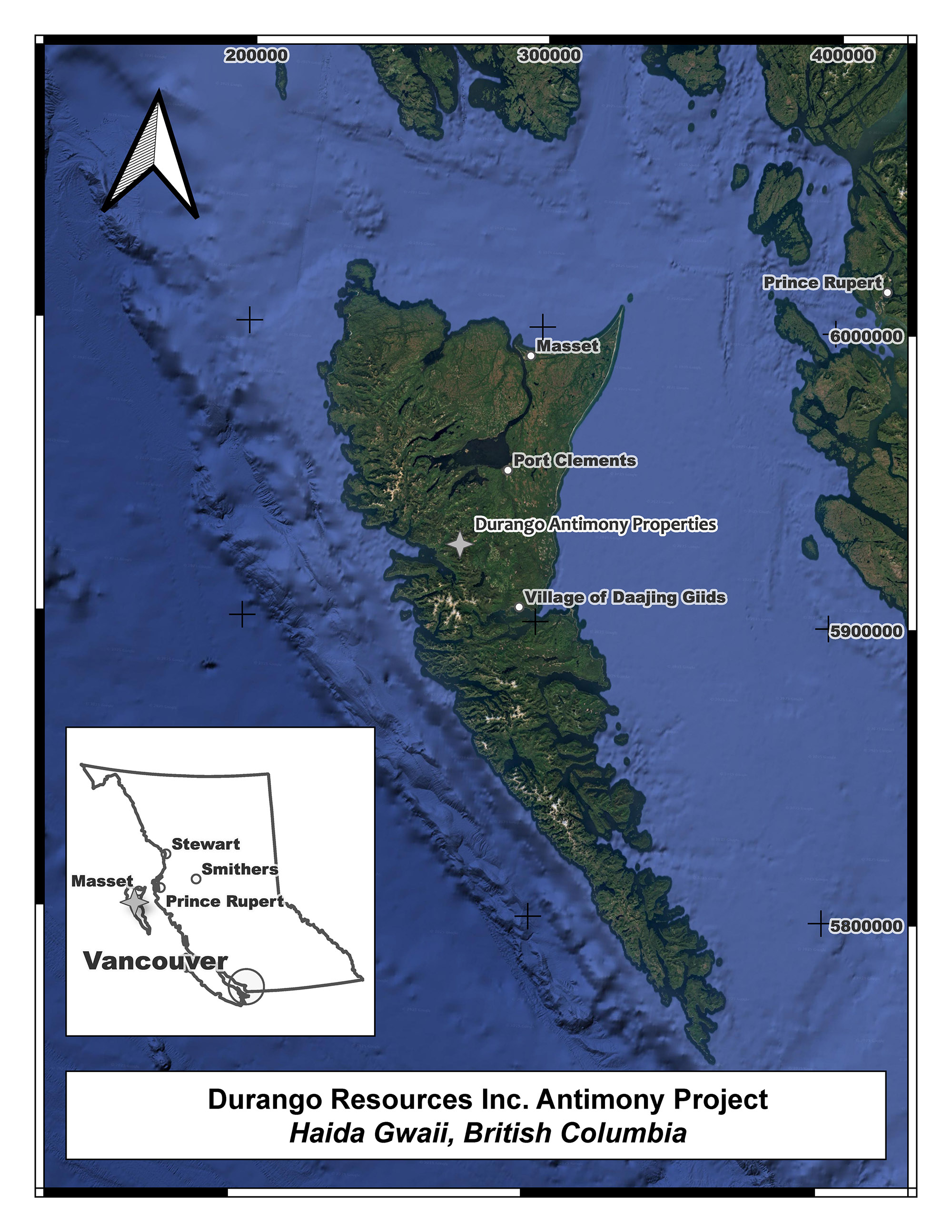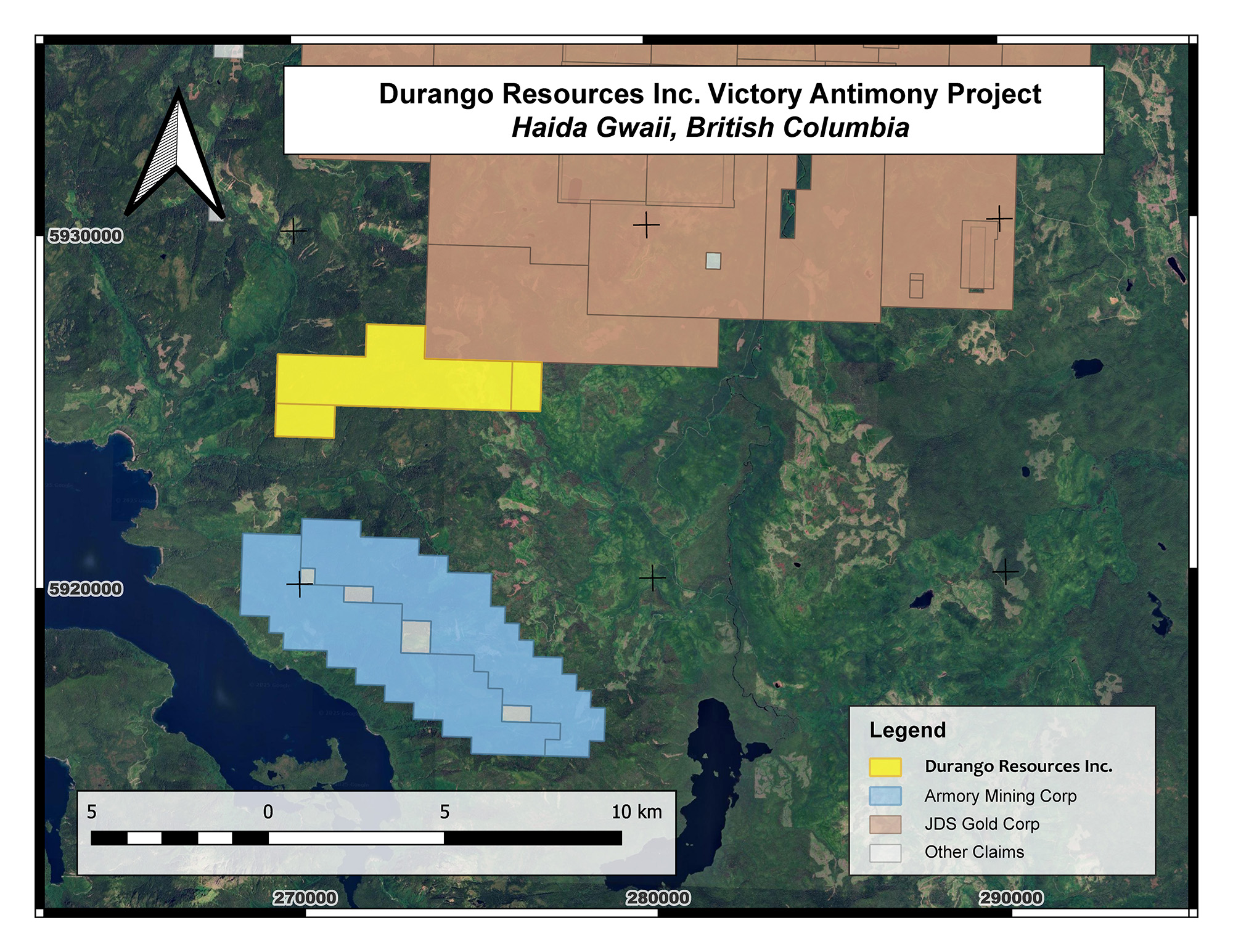I agree to and consent to receive news, updates, and other communications by way of commercial electronic messages (including email) from Durango Resources Inc. I understand I may withdraw consent at any time by clicking the unsubscribe link contained in all emails from Durango Resources Inc.
About the Victory Antimony Project
The Victory Antimony project is 100% owned (1,387 hectares) by the Company and covers an antimony occurrence which was discovered in 1988 by Newmont Exploration of Canada along a newly constructed logging road. A 1989 Assessment Report reported a chip sample of mineralized boulders assaying 11.8% arsenic, 1.24% antimony, and 0.136% mercury (Turner, 1989). Mineralization of the showing reported 5% stibnite (antimony mineral) and was reported to be exposed over a width of 2.5-3 metres over a length of 10-12 metres. The occurrence is described as being a hydrothermal hot spring deposit type within the Middle Jurassic Yakoun group pyroclastic andesites, volcanic sediments and argillites, which appears to be similar to the showing reported by Armory Mining Corp. which is adjacent to their Riley Creek project as announced on November 11, 2024. The Victory Property was acquired by Durango as part of the Company’s strategy to explore and advance critical metals within Canada.
About Antimony
Antimony is a critical mineral primarily used as a flame retardant and alloying agent in lead-acid batteries, ammunition, and semiconductors. It also has strategic applications in defense and energy storage technologies, making it a high-priority material for many governments. The global antimony market is forecasted to grow at a compound annual growth rate (CAGR) of 5.5% from 2023 to 2030, driven by rising demand in renewable energy storage and military applications.
China dominates global antimony production, accounting for over 70% of supply, leading to significant supply chain risks. This concentration creates vulnerabilities for industries and countries reliant on antimony for essential applications. In December 2024, China banned exports of antimony to the United States, citing its dual military and civilian uses, further exacerbating supply chain concerns.
The U.S. Department of Defense has designated antimony as a critical mineral due to its importance in national security, and governments are now prioritizing domestic production to mitigate supply chain disruptions. Antimony has been on the critical mineral list in Canada for a significant period of time. Projects exploring antimony sources in North America play a key role in addressing these challenges.
About Critical Metals
Critical metals are essential components in modern technologies, including renewable energy systems, defense applications, and advanced electronics. Both the United States and Canada have identified specific lists of critical minerals vital to their economic and national security. The U.S. Geological Survey’s 2022 list includes 50 critical minerals, while Canada in 2024 has designated 34 minerals as critical.
Recent geopolitical developments have heightened concerns over the supply chain security of these critical metals. China, which holds a dominant position in the production and processing of several critical minerals, has implemented export bans affecting the West. Notably, in December 2024, China banned exports of gallium, germanium, and antimony to the United States, citing their dual military and civilian uses. Following this, in February 2025, China imposed extensive export controls on five additional strategic metals: tungsten, indium, bismuth, tellurium, and molybdenum. These metals are essential for various industries, such as defense, clean energy, and consumer electronics.
These actions underscore the strategic importance of diversifying supply chains and developing domestic sources for critical metals to mitigate geo-political risks and ensure the stability of essential industries.


